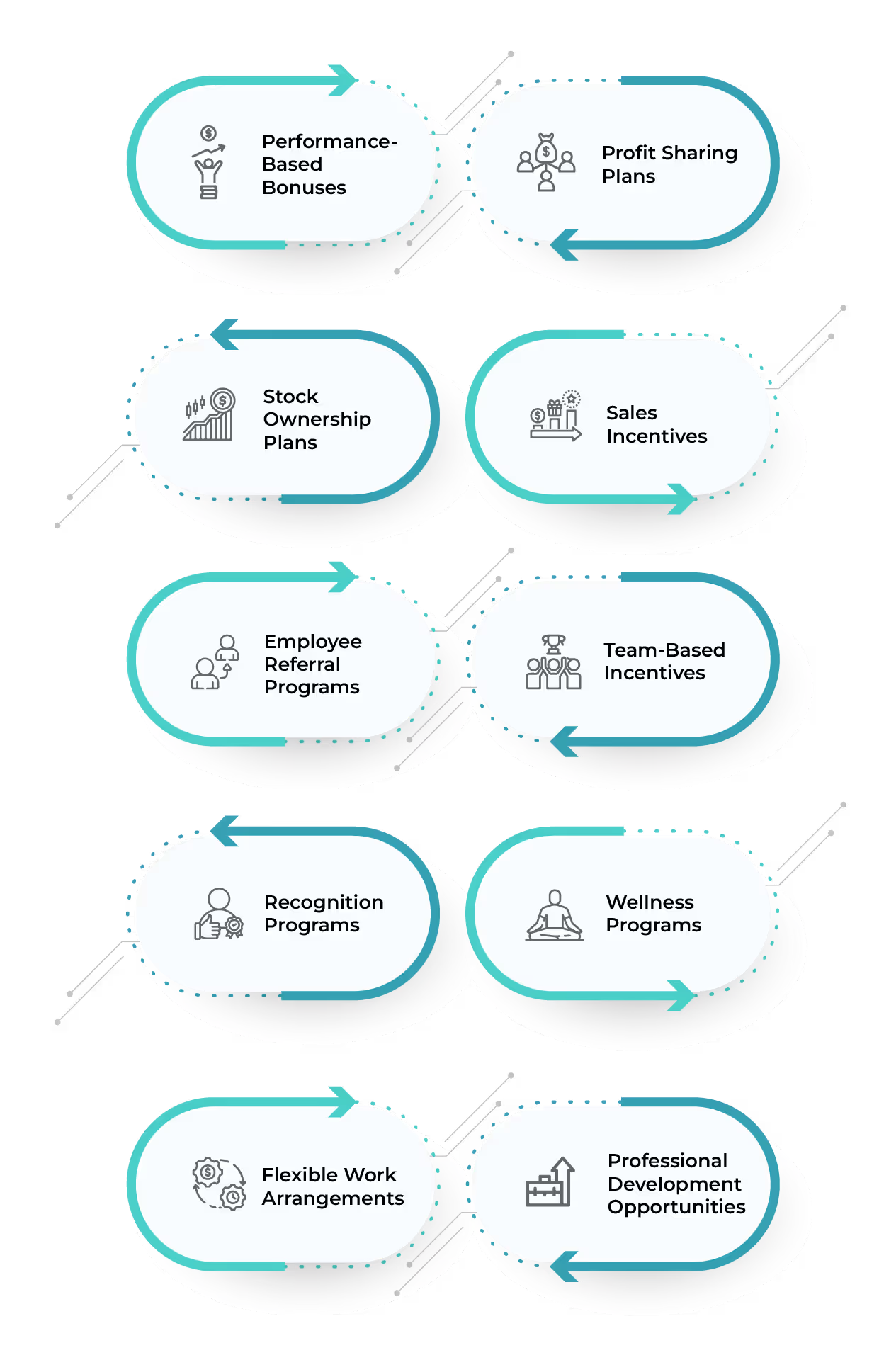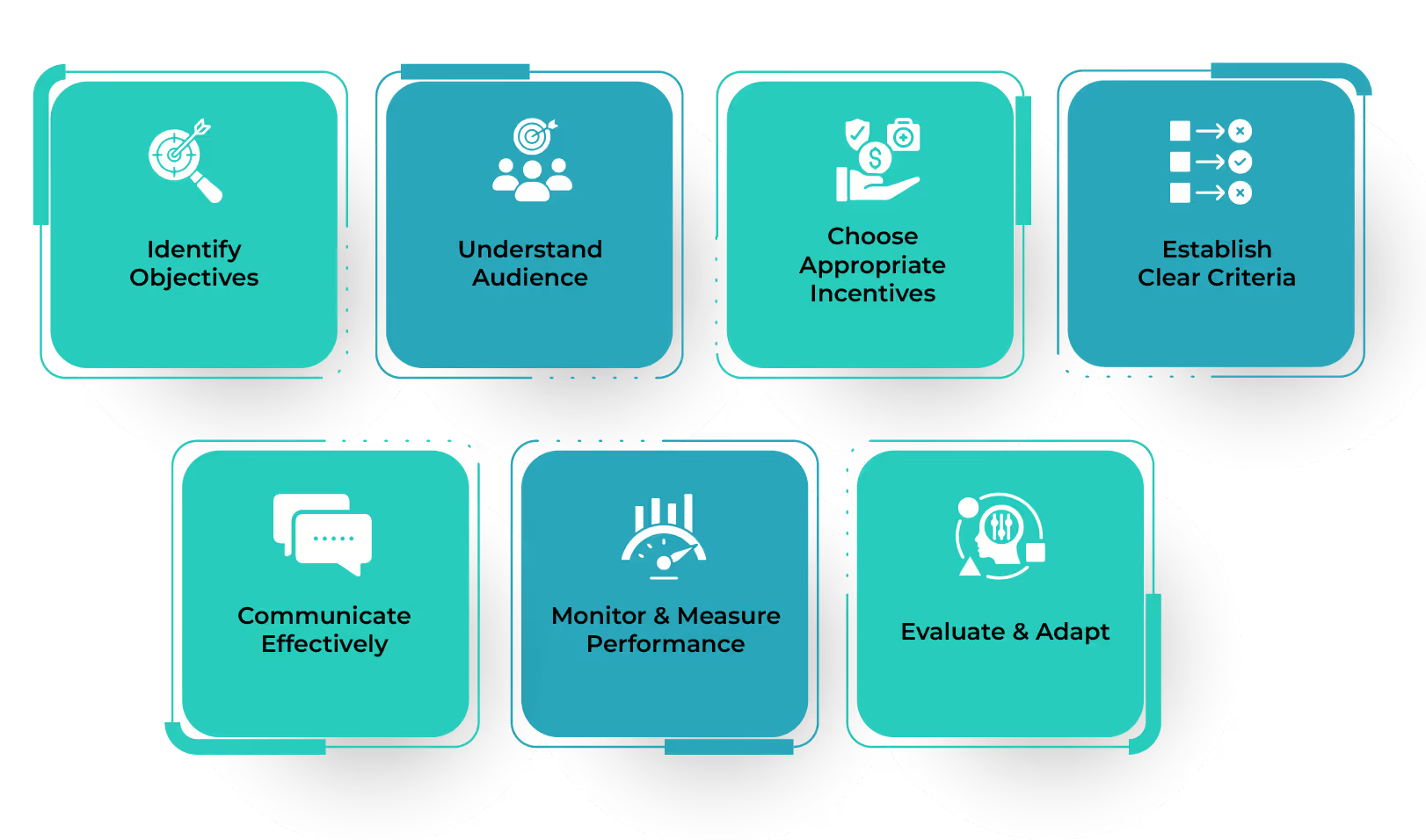
Blog
Understanding Corporate Incentive Programs
May 15, 2024


Key Insights
How often have you felt doubtful of your potential? Thinking if you are doing enough? Feeling conscious you are not meeting expectations.
In a corporate environment, feelings like these are regular.
To remove such employee thoughts companies must set up a system where you can evaluate their performance and provide them constructive feedback.
What more effective tool to fulfill this requirement than a corporate incentive plan?
A motivational tool that objectively measures performance and helps employees know their strengths and areas of improvement.
This blog will give you a comprehensive idea about corporate incentive plans, why they matter, and their common types. We will help you design and implement an effective corporate incentive plan.
The article also delves into the challenges in corporate incentives and best practices to enhance them.
What are corporate incentives?
Corporate incentives are rewards to motivate your employees and enhance their performance. It can be both monetary or non-monetary depending on the employee's achievement or preferences.
It aims to enhance performance, foster engagement, enhance retention, and achieve company objectives. By enriching employee satisfaction and company culture, it drives organizational success.
Why Corporate Incentives Matter?
Corporate incentives serve various purposes within the company. It drives performance, enhances engagement, fosters a healthy workspace, and drives growth.
When companies recognize their employee's achievements it enhances their confidence and motivates them to perform well. It also helps create a sense of belonging and commitment to the organization.
Corporate incentives for employees are generally of two types- monetary and non-monetary. Monetary rewards give financial stability to employees and help them focus on their targets. Non-monetary rewards celebrate their achievements and create a sense of belonging and satisfaction.
This holds true for all your employees. From your senior executive's management incentive plans to sales reps' incentive program has a crucial role.
These efforts of recognizing your employee efforts will improve the retention rate. Besides, including such motivational tools also attracts top talents to your company.
Corporate incentives matter in today's workspace. They help create an employee-centered work culture that contributes to organizational success.
Common types of employee incentive programs:
Organizations have a wide variety of incentive types to choose from. Depending upon the achievement, company budget, and organizational goals these incentives can vary.
Let's look at this variety and choose the types of corporate incentives that best suit your requirements:

Performance-Based Bonuses
Employees receive this bonus based on their performance achievement. Evaluating performance based on specific key metrics ensures its objectivity.
Profit Sharing Plans
Here employees receive a percentage of the company’s profit as an incentive. Eligibility to the scheme depends on your tenure, position, or the deal you closed.
Stock Ownership Plans
Companies grant the right to own stock as an incentive to their employees. This ensures employee retention and that they work to achieve the long-term goals.
Sales Incentives
Sales reps can earn commissions, bonuses, and rewards as sales incentives. They become eligible when they close a deal, achieve sales targets, or exceed expectations within the time schedule.
Employee Referral Programs
Employees can earn incentives when they refer an ideal candidate for a job vacancy. This is usually distributed when the new joiner successfully completes their probation period.

Team-Based Incentives
Employees can earn incentives when their team or department achieves their targets. It is provided to enhance teamwork and collaboration.
Recognition Programs
Employee incentives can be in the form of public praise, awards, or certificates. While recognizing their achievements, you are also reinforcing their confidence and motivation.
Wellness Programs
Companies offer period leaves and health screening to promote employee health and well-being. Incentives in these forms make a positive impact on your company culture.
Flexible Work Arrangements
Today, companies offer flexible working hours, remote working options, remote workers rewards, or even a sabbatical. Corporate incentives in these forms aim to improve the employee's work-life balance.
Professional Development Opportunities
Employees look for development opportunities like workshops, training, and conferences from their companies. This ensures their consistent career growth and upskilling.
Most often, companies use a combination of these incentives. It can vary depending on the achievement, scenario, and company budget. Eventually, all aim to drive employee engagement, retention, and performance.
We have more examples of effective incentive programs. Check 20 Effective Employee Incentive Programs to Motivate Employees.
Designing Corporate Incentive Programs
Thoughtful planning takes you halfway toward your destination.
When you have a well-designed corporate incentive program it can streamline your entire sales process and operations.
This is important as companies hire employees from diverse backgrounds with varying preferences about their incentives.
Here is a step-by-step process to guide you in designing your corporate incentives.

Identify Objectives
The first step is to identify objectives. Understand what you aim to achieve through the incentive program.
Understand Audience
Understand who the recipients are. What their needs, requirements, and preferences are while looking for rewards.
Choose Appropriate Incentives
Each person and situation requires a different incentive. Keep a diverse range of incentives to appropriately recognize and reward your employees.
Establish Clear Criteria
Be clear about the eligibility criteria. Define the basis of employee evaluation and the metrics used for assessment.
Communicate Effectively
Communicate about all specifics of the incentive program. This includes a proper idea of the incentive program, the evaluation process, commission calculation, and payout schedule.
Monitor and Measure Performance
Regularly monitor the effectiveness of your incentive program. Checking if it's giving the desired results and fulfills employee satisfaction.
Evaluate and Adapt
No corporate incentive program is perfect. It requires regular evaluation and upgrades. This ensures maintaining its relevance and effectiveness consistently.
Following these steps help companies to derive their desired outcomes. From employee motivation to the overall success of the organization.
Implementing Employee Incentive Programs:
The effort you put into building an incentive program can go in vain if the implementation is not effective.
There are a few points to keep in mind to ensure you derive the most out of your incentive program.
- The first step to effective implementation is clear and transparent communication. Educate employees on the purpose, structure, eligibility, and other specifics of the program.
- Be fair in your incentive design. Consider the potential of sales reps while setting sales targets and eligibility criteria.
- Provide training to employees on understanding their incentive program. Guide them in understanding the evaluation process and ways to achieve their targets.
- Set targets that motivate employees rather than overwhelm them. These targets must be specific, measurable, achievable, relevant, and with a time schedule.
- Managers must regularly evaluate the effectiveness of the incentive program. Check if employees are happy with their rewards and if it brings the desired outcomes.
- Always be open to change and update. With changing market trends, and competitor standards, companies must adapt their incentive program.
Including these tips in your everyday practices will help enhance your incentive program.
Examples of monetary and non-monetary incentives:
We have already discussed that corporate incentives examples are of two types.
Monetary rewards provide financial stability and non-monetary rewards create a sense of achievement.
Let us look at a few examples of these two types for better understanding.

Do you wish to read more about incentive types? Check A Comprehensive Guide to Types of Variable Incentives.
Best Practices for Corporate Incentive Programs:
Small actions speak volumes. Small steps lead to a long journey. Every day small efforts make big differences.
It is these small steps that make a huge impact on your incentive program. Best practices that enhance effectiveness on your employees, operations, and the organization.
Let's look at what these best practices are and how they impact your incentive program:
Customize your incentive based on employee preferences
Tailor your incentives based on employee preference and potential. Incentives that cater to their needs and requirements will enhance motivation and performance.
Provide continuous feedback for improvement
Evaluate performance and provide feedback for improvement. This helps sales reps understand their strength, and areas of improvement and make changes for improvements.
Recognize and celebrate your employee’s achievements
Always celebrate your employee’s milestones. Recognize their achievements and reward them through words of praise or prizes. This reinforces their confidence and dedication.
Take a data-driven approach to decision-making
Include incentive automation tools to provide real-time visibility to both management and employees. It provides valuable data to make insightful decisions on your incentive program.
Take employee feedback and involvement
Incentive programs can be optimized only through employee participation. Gathering their feedback and input will help in ensuring its relevance and effectiveness.
Review incentives regularly for changes
Regularly review your employee incentive performance. This helps make the required changes to meet the evolving employee preferences and company needs.
These tried and tested practices can ensure the effectiveness of your incentive program. From driving engagement, motivation, and performance to ensuring company growth and success.
Overcoming Challenges in Corporate Incentive Programs
It's not necessary that this whole process of building and maintaining an incentive program be smooth. Challenges and hurdles are bound to arise at any stage.
What are these challenges in corporate incentive programs? How can you resolve it? Let's find out:
Challenge: There can be a lack of clarity on the incentive program
Solution: Managers must provide detailed sessions on every aspect of the incentive. Create a rapport with your team so that they feel free to ask doubts and be patient to answer.
C: Employees might show resistance to the new incentive program
S: Make employees a part of the incentive program. Taking their opinion and feedback, giving them proper ideas about its benefits, and making them feel included.
C: Employees might doubt the fairness of the program
S: Communicate all aspects of the program management. From the individual performance metrics, and eligibility criteria to the calculation process and payout schedule. This helps them understand the evaluation is fair and transparent.
C: The incentive program might face budget constraints.
S: Managers must conduct a sales forecast to estimate the probable expenses for the financial year. This helps plan the incentive program within the budget. Also, make use of budget and resources optimally.
C: The incentive program might not provide the desired outcome.
S: Regularly evaluate the effectiveness of the program. Check if it is bringing the desired output, if the employees are happy, and if the operation is optimized with the existing resources.
Companies must be proactive in anticipating and addressing these challenges. Even when bottlenecks arise, you must rise to the situation to resolve the challenges. This ensures optimal output from the corporate incentive program.
Wish to know more about incentive plans. Check Long-Term Incentive Plans: Understanding Types and Strategies.
Final Thoughts
Companies cannot expect consistent performance without acknowledging your employee’s efforts.
Today workspaces are trying to be more and more employee friendly. And you cannot deny the significance of words of praise and feedback in motivating your employees.
Do not be a miser while appreciating your employees' efforts. However, remember to provide constructive feedback while pointing out their areas of improvement.
Even negative incentive example can be incorporated in your incentive practices to enhance the overall outcome.
These are minute but significant changes in your management that can have a huge impact on your employee morale and work culture.
That is why time and again we have talked about the relevance of automating your corporate incentives. The time for incorporating automation tools has become inevitable.
You need to give your employees the clarity and transparency of the incentive program. You need to give them real-time visibility on their work progress. You need to show the incentive they earned and the possible amount they can earn.
The more they have access to this information, the better they can plan their sales process.
That is where Kennect enters to help your corporate incentive plans.
We can supercharge your incentives with our cutting-edge solution. We automate your entire sales incentives process to save you time and ensure accuracy.
Want to know more, Book A Demo with us NOW!
ReKennect : Stay ahead of the curve!
Subscribe to our bi-weekly newsletter packed with latest trends and insights on incentives.
Thank you! Your submission has been received!
Oops! Something went wrong while submitting the form.
Your data is in safe hands. Check out our Privacy policy for more info














